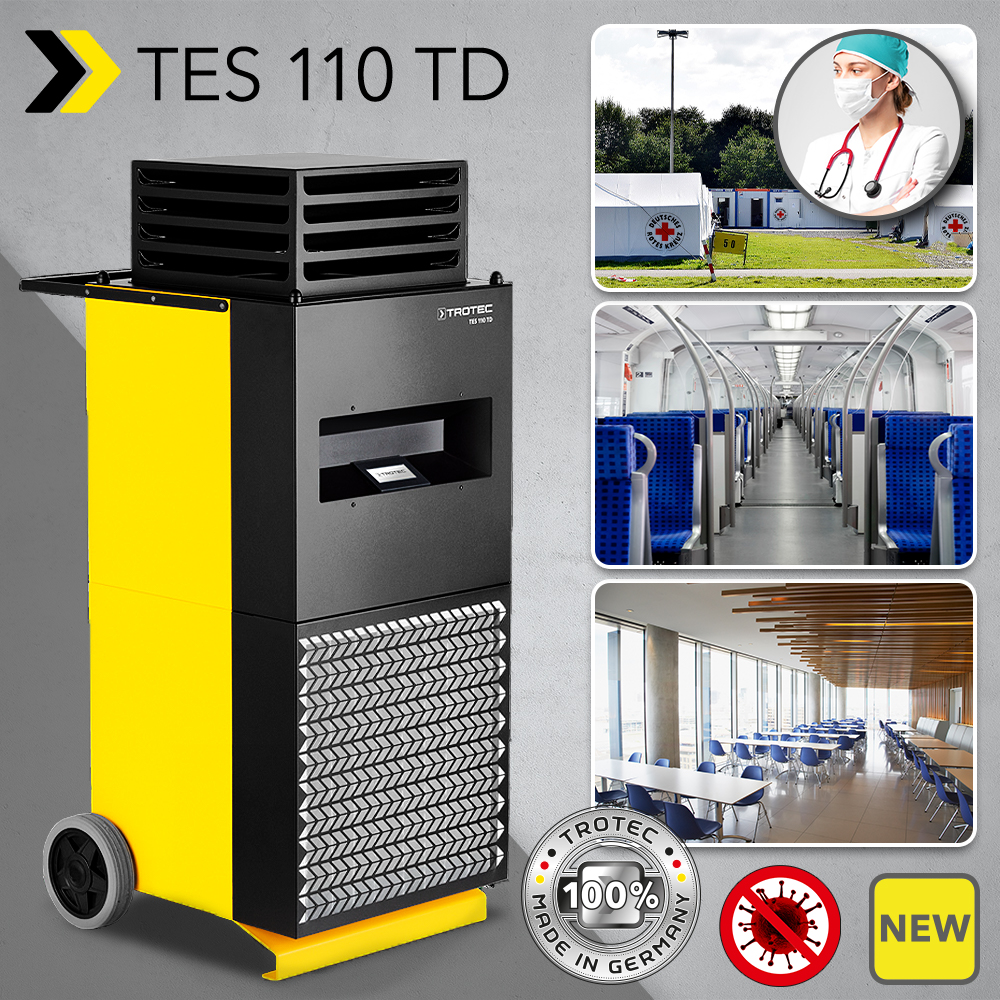In addition to the previously known measures for chemical disinfection by means of spray or wipe disinfection, there is also the rather less known but effective thermal disinfection. This is the thermal treatment of room air to inactivate viruses or disinfect surfaces. Here, the fact that viruses such as the influenza or corona virus (SARS-CoV-2 / Covid-19) die within 15-30 minutes at temperatures of 56 °C is important.
Professional disinfection measures can be divided into chemical disinfection (wipe and spray disinfection) and thermal disinfection by means of virus-inactivating treatment of the room air. In contrast to chemical disinfection, thermal disinfection works without chemicals. Chemical disinfection of rooms and surfaces using disinfectants is by far the most common method. Depending on the application, the chemical is sprayed, wiped or moistened by misting the surfaces. Disinfectants are currently purchased in enormous quantities and there are already bottlenecks in delivery.
On the other hand, there are also still largely unknown but very effective disinfection methods that do not destroy the viruses by reacting with a liquid chemical, but by using cheaper, faster and above all more environmentally friendly methods.
Viruses die at temperatures of 56 °C within 15-30 minutes
In studies such as ‘The Effects of Temperature and Relative Humidity on the Viability of the SARS Coronavirus’ or ‘First data on stability and resistance of SARS coronavirus compiled by members of the WHO laboratory network’ released by the World Health Organisation, it was found that at a heat of 56 °C, the SARS coronavirus dies at a rate of about 10 000 units per 15 minutes. This is known as rapid reduction. The virus is generally very stable, as it remains stable for 3 weeks at room temperature in a liquid environment. However, after heating to 56 °C for 15 minutes, infectivity is lost. Even the hepatitis C virus (HCV) is scientifically proven to be heat-sensitive and can be inactivated at 56 °C in 40 minutes. At 60 °C or 65 °C it can even be inactivated in 8 minutes according to the study “Thermal stability and inactivation of the C virus grown in cell culture”
Special heaters ensure deadly temperatures for viruses
In thermal disinfection, the room or the surfaces in it are heated to just over 56°C for at least 30 minutes by means of special heaters that operate with the aid of an intelligent automatic control system. Sensors ensure that the temperatures, which are deadly for viruses, are also reached where they prefer to “stay”, i.e. on surfaces in buses, carriages, waiting rooms, canteens and there e.g. on tables, backrests, handles or seats etc.
Advantages and disadvantages of the thermal process for inactivating viruses
The thermal treatment of indoor air to inactivate viruses has the advantage that no chemicals are used and only hot air is produced. This makes this process fast and above all reliable. The room can be used again immediately after the treatment. This is not possible with chemical treatment such as fogging (spray disinfection) or wet wipe disinfection.
Disinfectants are effective – that is undisputed. Disinfectants are safe – that too is undisputed. But it is only effective and safe where it has been correctly applied or wiped off in the end! Have all surfaces in the room really been wiped, applied or sprayed correctly and without gaps? The heat, which is deadly for viruses, comes without gaps even in places that are difficult to access. In contrast to ozone, the thermal process allows the room to be used directly and, moreover, at 56 °C we are not talking about temperatures that are dangerous for humans. Every sauna is considerably warmer at 80°C – 90°C. This advantage can be used especially for applications in public transport in wagons, buses, canteens, with the currently installed treatment containers for quick tests as well as mobile clinic or hospital systems on container basis.
The disadvantage of this method is a certain power consumption of approx. 4.50 – 9.00 EUR per treatment on the basis of a mobile standard hospital container and the required power connection of 400 V / 32 A, which is not available everywhere. However, apart from the installation, which usually takes less than 5 minutes, there are no further personnel costs. If several rooms have to be treated at the same time, the personnel costs per treatment unit are reduced even further.
Only heaters with certain program controls ensure correct treatment
As these products are individually programmed to meet specific requirements and areas of application, it is not enough to simply install a standard electric heater. For this purpose, special heaters have been developed which do not switch off at such high temperatures, and also time programs have been developed which run when a special sensor system determines that the required temperature has been reached on corresponding surfaces.
The Trotec team can advise you on the thermal inactivation of viruses
The Trotec team will be happy to advise you on your individual problems, circumstances and dimensions. Either by telephone on +2452-962 530 or by-email to info@trotec.de


